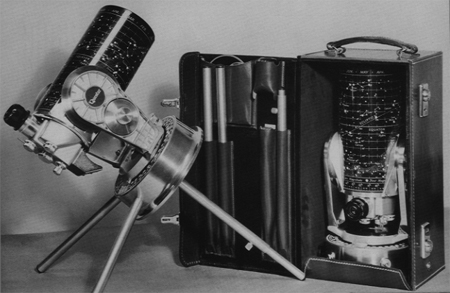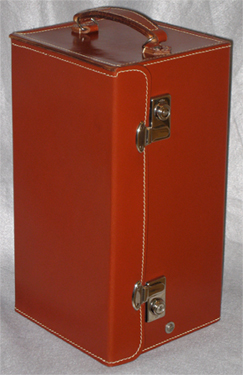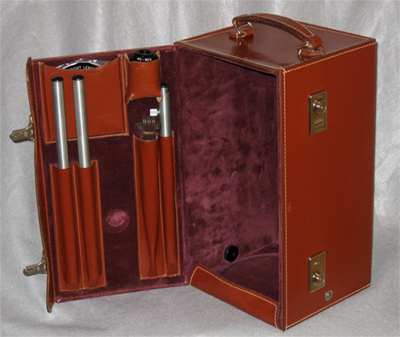Questar Distribution
![]() News
News ![]() Notes & Interesting Articles
Notes & Interesting Articles ![]() Overview
Overview ![]() Pricing
Pricing ![]() Products
Products ![]() Service or Repair
Service or Repair
Questar Telescopes ![]() LD Surveillance Systems
LD Surveillance Systems ![]() LD Microscopes
LD Microscopes ![]() Accessories
Accessories


Original Model Leather Case For Questar 3-½ Telescopes
Among the accessory items that were provided with each new Questar 3-½ telescope sold from 1954 through 1968.This article is provided as a courtesy by Company Seven for those customers who have helped to keep us in business.
 The Questar literature of the period describes it as:
The Questar literature of the period describes it as:
-
"FINEST BRITISH COWHIDE, each one made by hand for us in Staffordshire, England. Deep luggage tan color, fully velvet lined in old wine color, leather pouches for accessories. Conservative white stitching, two locks. Rim of Questar's base held in case by adjustable eccentric Synthane disks."
Background: the Questar telescope has since 1954 been recognized as an elegant and refined practical tool for astronomy: the Rolls-Royce of telescopes. Among the accessories that distinguished the Questar was the custom fitted rigid case provided as a standard accessory with each new astronomical telescope. The Questar telescope slides into the larger portion of the case, while the door interior has pouches sewn in to accommodate those accessories that were provided with the Questar. The case was hand crafted in England of two ply stitched Saddle Leather, with the interior fully lined in velvet. The leather is pliable and without any additional interior bracing, yet it is rigid enough to retain its shape and hold the seven pound Questar 3-½ safely in transit.
Right: Questar 3-½ shown both in its Pole Aligned mode, and also stored within its Leather Case (73,788 bytes)
Click on image to see enlarged view (149,049 bytes).
By the Spring of 1968 the stock of this original saddle leather case was depleted as it was replaced by a newly sourced rigid leather case that could accommodate either the Questar Standard or the slightly bulkier Duplex telescopes. This was a hard case consisting of a wood frame with leather covering, with a similar opening front door and latch arrangement to store the accessories. This case was made in the USA for Questar by the Chick Luggage Company of New York. This appealed to the ambitions of Questar's founder Lawrence Braymer and his wife Peggy to make the Questar an entirely "Made in The USA" commodity.
By the late 1970's the Chick Luggage Company went out of business and the leather case was dropped from the product line altogether. Years later, in response to prodding by Company Seven and possibly some at Questar too, Earlene Austin the President of Questar at the time agreed to revisit the idea of a leather case. In 1990 a prototype leather case was made (now in Company Seven's Museum Collection), and in 1991 the Deluxe Leather Case was made available as an upgrade option in place of the standard vinyl case when ordering a new Questar Questar Standard or Duplex astronomical telescope. The Deluxe Leather Case is provided as standard equipment with the limited production Questar 50th Anniversary Model telescope.
 Arrangement: The case is designed to hold the Questar telescope with all its standard accessories. The accessories provided with the telescope: Tripod Legs, Solar Filter, Aperture Stop, Spare Eyepiece, AC Power Cord, and two keys for the Latch Locks. These items store in leather pouches that are sewn onto the interior of the door lid. This is illustrated below.
Arrangement: The case is designed to hold the Questar telescope with all its standard accessories. The accessories provided with the telescope: Tripod Legs, Solar Filter, Aperture Stop, Spare Eyepiece, AC Power Cord, and two keys for the Latch Locks. These items store in leather pouches that are sewn onto the interior of the door lid. This is illustrated below.
Right: Original Questar Leather Case in Company Seven's Museum Collection (74,161 bytes).
Even decades later one can appreciate the craftsmanship of materials, even the latches appear much as new.
Click on image to see enlarged view (236,042 bytes).
The case is laid out well and is compact, light weight (especially compared to modern Questar cases), and is beautiful. There are some aspects that are unusual:
- There are no pads attached to the bottom of the case and so it rests flush against any surface it is placed upon. This makes it more likely that the bottom could be contaminated and stained so care must be taken where one places the case.
- The bottom of the case extends to the front of the case and beyond the walls to form a flap. The flap easily is held down to install the telescope, and it is pushed out when removing the telescope. This helps to hold the Base in place.
- The door is not hinged by means of any mechanical hardware, but it is a folded extension of the side wall of the case. The flap of the lid onto which the latch is attached is similarly formed to bend although it is not moving back and forth as often or as far. These bends (and the one mentioned above) are most prone to cracking and so they should be treated periodically with an approved saddle leather preservative.
- Rollers made of Synthane (an early laminated phenolic) are attached to either side of the case interior, these grasp the flange of the Questar telescope Base holding it in place securely. The hole drilled and tapped in these disks is off center, so when these are installed onto the case the disks can be rotated to adjust how they bite onto the flange of the Questar base.
The door lid is secured by two nickel plated steel spring loaded keyed laches, each cases included two keys. But do keep in mind these locks only serve to keep the honest person honest; anyone who really wants to get in can handily walk off with the Questar in the case and force these latches to the breaking point. The lock hardware was made by C.W. Cheney And Son Ltd., a famous maker of locks, keys, hinges, and other hardware. Cheney was established soon after World War I, based on Factory Road in Hockley, England but has since been acquired by other companies, moved from Factory Road after 2001, and little remains with the qualities of what they made in the era of the Questar cases.
Since these original carrying cases are appreciated by Questar owners, the set was shipped from the factory with a protective fabric cover to protect the case. Early covers resembled a pouch that closed with drawstring closure. While later Questar Corp. introduced optional case covers featuring a tailored fit for the carry case that would slip in, and with a flap lid with two snap fasteners. The materials and colors of the case covers varied over the 1960s and into the 1970s, until this accessory was discontinued altogether by about 1975.
Caveat Emptor: the original case can accommodate the Questar 3-½ telescope even with the optional Powerguide upgrade drive control system that was developed in the 1980's. However, installation of the later production version of the Powerguide II drive control system resulted in a slight increase of height of the telescope preventing it from fitting into the original case; those choosing to upgrade an older Questar were advised to buy a newer case to accommodate the telescope. The later Powerguide III do not impose any added height to the Base, so these can fit into the case though these original cases have no space to fit the Powerguide III Keypad.
Care and Precautions: this is a good grade of real leather and so it is subject to scuffing or rot if handled or stored inappropriately. We do not recommend setting the case in wet ground while observing for example. Some precautions:
- The leather should be periodically wiped down with a saddle leather cream or polish, this will keep the leather supple and prevent deterioration of the leather.
- Pay special attention to insure the lid bend and the Carrying Handle are treated generously with a lubricating leather conditioner. This will keep these areas supple and prevent cracking of the leather in these areas. It is also beneficial to treat the exposed outer surfaces of the leather pouches.
- If the leather becomes covered with dew for example, it is a good idea to wipe it down with a clean cloth and allow it to dry out in a climate controlled environment.
- When the Questar becomes covered with dew or frost, then it can be placed in the case for safe keeping. But as soon as it is practical, one should allow the case and telescope to acclimate to room temperature, then open the case and remove the telescope thereby allowing both the case and telescope to air out.
Company Seven recommends if you will be on the go quite a bit, or store the telescope in high humidity environments, or expose their case to corrosive seashore salt air (near breaking surf), or leave the set out for extended periods in sunlight, then you should opt for the standard vinyl case. We have some customer who want to have the entire Questar experience of a leather case, appealing to their sense of tradition, while also ordering a vinyl case to have it at times when they do not wish to risk damaging their leather case!
Company Seven has serviced Questar 3-½'s sixty years old where their original leather case still appears beautiful and has been well cared for, the ones in the best condition tend to have the optional case cover. We worked with Questar to bring back a modern version of the protective case cover, one with more durable exterior and padding too, and in the Fall of 2014 we introduced this option as PN 19179C. This is especially helpful for those who carry-on their Questar to aircraft, the cover reduces the chances of having their leather or vinyl covered carry case scraped.
 Original Leather Case Specifications
Original Leather Case Specifications
| Case Exterior Dimensions | 7-½ inches deep x 7-¾ wide x 14-½ tall 190 x 210 x 368 mm |
| Case Height To Top of Handle | 15-½ inches / 394 mm |
| Case Weight (empty) | 3 lb. 2 oz. / 1.4 kg. |
| Locking Latch | Two, keyed with spring loaded latch |
| Origin | Made in United Kingdom |
Right: case interior arrangement with standard accessories of the period: Solar Filter, Aperture Stop, 40-80X Eyepiece, AC Power Cord (wrapped as provided), Tabletop Tripod Leg set, two keys and a spline wrench in the pouch are not visible here (120,737 bytes).
Click on image to see enlarged view (332,733 bytes).
We invite you to visit our showroom near Washington, D.C. to see a Questar first hand or contact us by E-mail to info@company7.com, or by telephone 301-953-2000. The showroom is open Monday to Friday 11 am to 6 pm, Saturday 11 am to 5 pm. We are closed on Sundays, on U.S. Holidays, and from 25 December through 1 January.
Contents Copyright 1954-2020 Questar Corp. and Company Seven, All Rights Reserved

